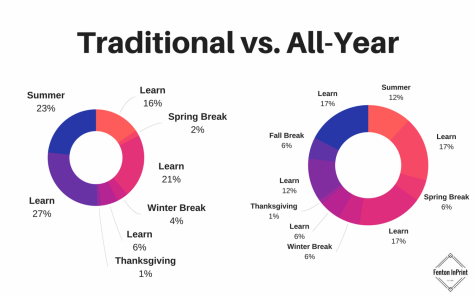All-year schooling should replace ten-month calendar to benefit students
July 26, 2017
PHOTO Gracie Warda
Summer vacation is something that most students have grown up with in the traditional ten-month calendar established early on in American history. However, this schedule isn’t optimal for maximizing student education or giving them an ideal learning environment.
Instead, a more efficient alternative has been increasing in popularity; all year schooling. The 45-15 plan is most common, where students attend school for 45 days and then get a 15 day break, according to the National Education Association. Other timetables include 60-20 and 90-30.
Both all-year and traditional school calendars include 180 school days in a year, however all-year plans almost eliminate summer learning loss. The New York Times estimates that 22% of what educators teach is review, in an attempt to make up for what’s lost over summer break. They also explain that this loss is cumulative, so an elementary student won’t lose as much as a high schooler.

All-year schooling also has the potential to benefit students in ways outside of their education. Parents still have to work, even when kids are on a ten to twelve week break. This causes problems (more so with younger students,) in terms of child care. The Department of Health and Human Services estimates that “affordable child care” costs roughly 10% of a family’s’ income- a wage that many can’t afford. This disconnect leaves children unattended at home during the summer months.
On a similar note, summer break poses an issue when it comes to feeding children. About one in four students at Fenton have free or reduced lunch costs, depending on family income. But over summer break, putting food on the table can be a struggle. Several organizations, such as Rotary Club, hold charity events for these families. However, without an extended summer break, these issues would be greatly reduced.
With so many benefits, it seems silly not to use the all-year calendar. The traditional calendar negatively affects students; not only in their education but in their home lives as well. The ten month calendar should be eliminated in order to maximize student learning.









